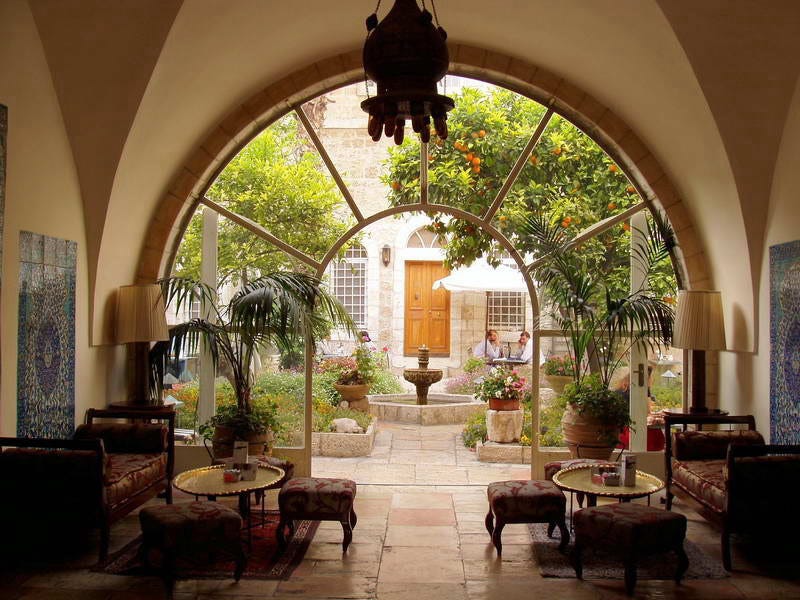This “bonus materials” note is going to all readers…not just paid subscribers. It seemed too important not to share with all.
Note
It is 100% and entirely coincidental that the first chapter in the Palestine section of On the the Road to Jericho is dropping as both the question of Gaza and South Africa is surging in the news.
I am deliberately not commenting on current events and news. There are other writers who are doing that brilliantly, who are on the ground, and who have far greater insight into current events than I.
But I am hoping that the story of a young South Africa diplomat in Palestine in 1997 may help towards understanding what is happening today, and why South Africa has taken the positions it has.
On using the word "Palestine”
When I arrived in the United States in 2001, I was quickly and forcibly admonished by some Americans that “there’s no such State as Palestine”, and told in no uncertain terms not to use the word, especially after 9/11.
Clearly I didn’t listen! Or rather I did…and I continue to use the word, because not using it is part of the problem.
I use the word “Palestine” just as I use the word “Israel”: to convey a people, a culture, a history, a land, an identify, and a national aspiration. All protestations to the contrary, the simple reality on the ground is that there are indeed “Palestinians” and “Israelis”. And the presence and naming of one—as land, state, or people—does not negate the existence of the other. That they have yet to figure out if and how to coexist either as two states, one state, or something else, does not erase the fact they do both exist.
By “Palestine” I mean the West Bank, Gaza and East Jerusalem, as marked by the “Green Line1”, and as consistent with UN Resolutions.
By “Israel” I mean the borders as agreeed upon in the 1949 Armistice Agreements between Israel and its neighbors (Egypt, Jordan, Lebanon, and Syria).
If the word “Palestine” is just that offensive to you, then you probably want to stop reading On the Road to Jericho now.
But if you are open to reading of the experiences of a South African diplomat in Palestine, then welcome and read on!
South Africa recognized the State of Israel in 1949, and the State of Palestine in 19952. The South African Embassy in Tel Aviv dealt with the State of Israel. (The Embassy was closed in November 2023, when South Africa severed ties with Israel.) The South African Representative Office in Ramallah, to which I was posted, dealt with the Palestinian National Authority. My life and work from 1997 to 2001 centered around Palestine and Palestinians, just like for the South Africans diplomats working at the Embassy in Tel Aviv their life and work centered around Israel and Israelis.
One of the more notable differences between our work, however, was that while, by necessity, I was constantly moving between Palestine and Israel and interacting with both Palestinians and Israelis as I moved about Jerusalem, went to the Embassy, travelled to Gaza, and generally explored the whole region (from Metula in the north, to Eilat in the south, from Gaza and Haifa in the west, to Jericho and the Golan Heights in the east), few South Africans in Tel Aviv came to either the West Bank and Gaza, or interacted with Palestinians3, on any regular basis.
The same pattern plays out for Israelis and Palestinians to this day. Palestinians must routinely interact with Israelis—primarily Israeli soldiers and settlers—throughout their lives. They must traverse Israeli military checkpoints, deal with Israeli administrative systems and apply for permits for work, travel, and construction. They often need to learn Hebrew for employment opportunities and dealing with authorities. Most Israeli citizens, however, can conduct their daily lives without engaging with Palestinians or learning Arabic.4
This is the nature of occupation: the citizenry of the occupied must know and interact with the occupier as part of their daily lives; the citizenry of the occupier can largely ignore the occupied in their daily lives.5
So even we South African diplomats, like the peoples of this area, lived two very different experiences depending on whether we were part of the Embassy in Tel Aviv or the mission in Ramallah.
Palestine Section Bonus Materials
In the Palestine section of the book, I am going to be much more sparing in the Bonus Materials.
Some of that is simple fatigue: it is a lot of work to pull together these additional bonus materials.
But the rest of it is also caution and humility. There is a wealth of material on the Palestine-Israel conflict. It is nearly 25 years since I lived there. My best contribution is, I believe, to focus on sharing primarily my own first-hand lived experience (lightly fictionalized, drawing mostly from the journals I started to keep at this time), and not to try to speak for or on behalf of Palestinians, or to attempt to explain a very long, complex and contested history. Others have done that much better than I.
If you want readable history; then some great places to start (and know that whatever I include, I am excluding other equally worthy reads!) are
Edward Said’s The Question of Palestine
Rhashid Khalidi’s The Hundred Year’s War on Palestine
For Palestinian memoirs (and the same caveat applies):
Fida Jiryis’s memoir, Stranger in My Own Land: Palestine, Israel and One Family's Story of Home
This list of notable Palestinian memoirs by Karim Doumar of the LA Times
LitHub’s 40 Books to Understand Palestine
Where it feels appropriate I will include links to the people, places, organizations etc. as mentioned in the text. But I’m not going to cover everything, or try and distill or summarize other people’s excellent writing.
Current Substacks worth following:
The American Colony Hotel: My first “home” in Jerusalem
The building was originally built and owned by an Ottoman Pasha Rabbah Daoud Amin Effendi al-Husseini, who lived there with his harem of four wives.
In 1895, the building was sold to a Christian group who arrived in Jerusalem in 1881 to set up a commune. Their leader was Horatio Spafford, a lawyer from Chicago and his wife, Anna. (Source: Wikipedia - The American Colony Hotel)
It became a hotel in the early 20th century, and is still owned by descendents of the Spaffords.
At the time I lived in Jerusalem (1997-2001), it was owned by Val Vester, who I came to know and saw almost weekly. Some of her story, and how she and her husband turned the hotel into an “oasis of neutrality” and place of secret talks can be found in her obituaries in the New York Time and The Times of London.
It is still very much in operation. More of it’s history, and historical photos, can be found here: https://www.americancolony.com/
“The Green Line, or 1949 Armistice border, is the demarcation line set out in the 1949 Armistice Agreements between the armies of Israel and those of its neighbors (Egypt, Jordan, Lebanon, and Syria) after the 1948 Arab–Israeli War. It served as the de facto borders of the State of Israel from 1949 until the Six-Day War in 1967, and continues to represent Israel's internationally recognized borders with the two Palestinian territories: the West Bank and the Gaza Strip.” Source: Wikipedia, Green Line (Israel)
“As of June 2024, the State of Palestine is recognized as a sovereign state by 146 of the 193 member states of the United Nations, or just over 75% of all UN members. It has been a non-member observer state of the United Nations General Assembly since November 2012.” Source: Wikipedia, International recognition of the State of Palestine. It is primarily the US’s veto power on the UN Security Council that continues to prevent Palestine from becoming a member state of the United Nations.
About 20% of the Israeli population are “Arab-Israelis”. They are descendants of the Palestinians, Bedouins, and Druze who remained/ were not expelled in what became Israel after 1948. While they were granted full citizenship rights, they were under martial law in Israel until 1966 (Jewish Israelis were not). To this day they often face various forms of social and institutional discrimination. They mostly live in Arab-majority towns and cities, some of which are among the poorest in the country, and generally attend schools that are separated to some degree from those attended by Jewish Israelis. For more on complexities of “Arab-Israeli” identity, see Arab citizens of Israel on Wikipedia
Israel has compulsory military service for all citizens. Many are deployed to the West Bank or Gaza for parts of their military service.
Other examples include:
French Occupation of Algeria (1830-1962): Algerians had to learn French, adapt to French administrative systems, and interact with French authorities and settlers for basic needs like employment and education. French citizens in metropolitan France could go about their daily lives with little awareness of Algerian realities, even though Algeria was considered an “integral” part of France.
Japanese Occupation of Korea (1910-1945): Koreans were required to learn Japanese, adopt Japanese names, and engage with Japanese officials, businesses, and educational systems. Japanese citizens on the home islands could remain largely unaware of Korean perspectives and daily struggles under colonial rule.
British Raj in India (1858-1947): Indians had to engage with British administrative systems, learn English for advancement, and adapt to British legal frameworks and education systems. The average British citizen back in Britain, however, could live their entire life without meaningful interaction with Indian people or culture, despite India being the "crown jewel" of the empire. While they consumed Indian goods and benefited from colonial wealth, they didn't need to learn local languages or understand Indian social systems.
The pattern holds true across many other historical occupations - the occupied population must develop extensive knowledge of , and adapt to, the occupier's systems, while the occupying population can often remain largely insulated from the realities of those they occupy.






